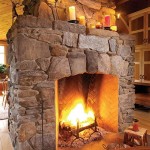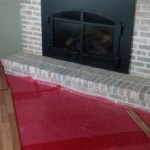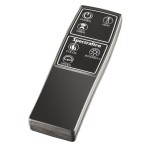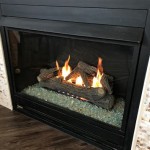Gas Fireplace Insert With Thermostat: Enhancing Home Heating and Comfort
A gas fireplace insert with a thermostat represents a significant upgrade to traditional fireplaces, offering improved energy efficiency, convenience, and precise temperature control. These inserts are designed to be installed directly into existing fireplace openings, transforming them into modern, efficient heating appliances. The integration of a thermostat enables maintaining a consistent and comfortable room temperature, minimizing energy waste and optimizing heating performance.
The primary function of a gas fireplace insert is to provide supplemental heat to a specific area of a home. Unlike traditional wood-burning fireplaces, which can lose a significant amount of heat up the chimney, gas inserts are designed to retain and radiate heat into the room. The sealed combustion chamber and direct vent system contribute to increased efficiency and safety. With a thermostat, the insert can automatically adjust its heating output based on the desired temperature setting, ensuring a comfortable and consistent environment.
Understanding the components and operation of a gas fireplace insert with a thermostat is crucial for making an informed purchasing decision and maximizing its benefits. The insert typically includes a burner system, a gas valve, a control module, a blower fan, and a thermostat. The burner system combusts natural gas or propane to generate heat. The gas valve regulates the flow of gas to the burner, controlled by the thermostat and the control module. The control module is the brain of the unit, processing signals from the thermostat and managing the operation of the gas valve and blower fan. The blower fan circulates heated air into the room, enhancing heat distribution. The thermostat monitors the room temperature and signals the control module to adjust the burner output accordingly.
Key Advantages of Gas Fireplace Inserts With Thermostat
Gas fireplace inserts with thermostats offer several compelling advantages over traditional fireplaces and other heating solutions. These benefits include improved energy efficiency, enhanced convenience, and precise temperature control, leading to a more comfortable and cost-effective heating experience.
Energy Efficiency: One of the most significant advantages of gas fireplace inserts is their energy efficiency. Traditional wood-burning fireplaces often lose a substantial amount of heat through the chimney, resulting in low overall efficiency. Gas inserts, on the other hand, are designed to be highly efficient, with many models achieving efficiency ratings of 70% or higher. This means that a greater percentage of the energy consumed is converted into usable heat, reducing energy waste and lowering heating costs. The sealed combustion chamber and direct vent system minimize heat loss and ensure that combustion byproducts are safely vented outside the home. The thermostat further enhances energy efficiency by automatically adjusting the burner output based on the desired temperature, preventing overheating and unnecessary energy consumption.
Convenience: Gas fireplace inserts offer a level of convenience that is unmatched by traditional fireplaces. Unlike wood-burning fireplaces, which require manual loading of wood, starting a fire, and constant monitoring, gas inserts can be operated with the push of a button or the flip of a switch. The thermostat allows for automatic temperature control, eliminating the need for manual adjustments. Many models also come with remote controls, enabling users to adjust the temperature and flame height from the comfort of their couch. Furthermore, gas inserts do not produce ash or soot, minimizing the need for cleaning and maintenance. This convenience makes gas fireplace inserts an ideal heating solution for busy homeowners who want to enjoy the warmth and ambiance of a fireplace without the hassle of traditional wood-burning.
Precise Temperature Control: The thermostat is a key component of a gas fireplace insert, providing precise temperature control and ensuring a consistent and comfortable room temperature. The thermostat monitors the room temperature and signals the control module to adjust the burner output accordingly. This allows the insert to maintain the desired temperature, preventing overheating or underheating. Some thermostats offer programmable settings, allowing users to set different temperatures for different times of the day or week. This feature can further enhance energy efficiency and comfort, particularly during periods when the home is unoccupied. Precise temperature control also contributes to a more even distribution of heat throughout the room, eliminating cold spots and creating a more comfortable environment.
Factors to Consider When Choosing a Gas Fireplace Insert With Thermostat
Selecting the right gas fireplace insert with a thermostat involves considering several factors to ensure that the chosen model meets specific heating needs, budget constraints, and aesthetic preferences. These factors include heating capacity, venting requirements, thermostat features, and aesthetic design.
Heating Capacity: The heating capacity of a gas fireplace insert is measured in British thermal units (BTUs) and indicates the amount of heat the unit can produce. It is crucial to select an insert with a heating capacity that is appropriate for the size of the room or area to be heated. An undersized insert will not be able to adequately heat the space, while an oversized insert may overheat the room and waste energy. To determine the appropriate heating capacity, it is necessary to consider the square footage of the room, the insulation levels, and the climate zone. Online BTU calculators can assist in estimating the required heating capacity based on these factors. Consulting with a qualified HVAC professional can also provide valuable guidance in selecting the right size insert.
Venting Requirements: Gas fireplace inserts require proper venting to safely exhaust combustion byproducts outside the home. There are two main types of venting systems: direct vent and B-vent. Direct vent systems draw combustion air from outside the home and vent exhaust gases directly outside through a sealed pipe. This type of venting is the most efficient and safest option, as it minimizes the risk of indoor air contamination. B-vent systems, on the other hand, use indoor air for combustion and vent exhaust gases through an existing chimney. B-vent systems are less expensive to install but are also less efficient and may be subject to more stringent building code requirements. It is essential to ensure that the chosen gas fireplace insert is compatible with the existing venting system or that a new venting system is installed according to local building codes. A qualified HVAC professional can assess the venting requirements and recommend the appropriate venting system for the specific installation.
Thermostat Features: The thermostat is a critical component of a gas fireplace insert, and its features can significantly impact the user experience. Some thermostats offer basic on/off control, while others provide more advanced features such as programmable settings, remote control operation, and energy-saving modes. Programmable thermostats allow users to set different temperatures for different times of the day or week, optimizing energy efficiency and comfort. Remote control operation provides added convenience, allowing users to adjust the temperature and flame height from anywhere in the room. Energy-saving modes, such as setback settings, can automatically lower the temperature when the home is unoccupied, further reducing energy consumption. It is important to consider the desired level of control and convenience when selecting a gas fireplace insert with a thermostat.
Installation and Maintenance Considerations
Proper installation and regular maintenance are essential for ensuring the safe and efficient operation of a gas fireplace insert with a thermostat. Installation should be performed by a qualified HVAC professional, and maintenance should be conducted on a regular basis to prevent potential problems and extend the life of the unit.
Professional Installation: Installing a gas fireplace insert requires specialized knowledge and skills to ensure that it is done safely and according to local building codes. A qualified HVAC professional will be able to properly connect the gas line, install the venting system, and test the unit to ensure that it is operating correctly. Attempting to install a gas fireplace insert without the necessary expertise can be dangerous and may void the warranty. Professional installation also ensures that the unit is properly sized and vented, maximizing its efficiency and safety. Furthermore, a professional installer will be familiar with local building codes and regulations, ensuring that the installation meets all requirements. Choosing a reputable and experienced HVAC professional is crucial for a successful installation.
Regular Maintenance: Regular maintenance is essential for keeping a gas fireplace insert operating safely and efficiently. The frequency of maintenance will depend on the usage of the unit, but generally, it is recommended to have the unit serviced annually by a qualified HVAC professional. Maintenance tasks typically include inspecting the burner system, cleaning the burner ports, checking the gas pressure, inspecting the venting system, and cleaning the blower fan. These tasks help to prevent potential problems such as gas leaks, carbon monoxide buildup, and reduced heating efficiency. In addition to professional servicing, homeowners can perform some basic maintenance tasks themselves, such as cleaning the glass door and checking the venting system for obstructions. Following the manufacturer's recommendations for maintenance will help to extend the life of the unit and ensure its safe and efficient operation.
Safety Precautions: Gas fireplace inserts, like all gas appliances, require certain safety precautions to prevent potential hazards. It is essential to install carbon monoxide detectors in the home and to test them regularly. Carbon monoxide is a colorless and odorless gas that can be deadly if inhaled. If a carbon monoxide detector alarms, it is important to evacuate the home immediately and contact the fire department or a qualified HVAC professional. It is also important to keep flammable materials away from the fireplace insert and to never store anything on top of or near the unit. Regularly inspecting the venting system for obstructions and ensuring that the gas line is properly connected are also important safety measures. Following these safety precautions will help to prevent potential accidents and ensure the safe operation of the gas fireplace insert.

Contemporary Gas Fireplace Inserts Provide Several Benefits Kozy Heat Fireplaces

Gas Fireplace Inserts Hvac Seattle Snohomish Skagit County Sun Energy Services

White Mountain Hearth By Empire Comfort Systems Direct Vent Gas Fireplace Insert Loft

E44 Large Gas Insert Call For 4998

Belmont Small Gas Insert

Regency Energy E33 Gas Fireplace Insert Hearth Appliances

Gas Fireplace Inserts Napoleon Fireplaces

All About Gas Fireplace Inserts Advice We Love Fire

Procom 26 000 Btu Vent Free Dual Fuel Propane And Natural Gas Indoor Fireplace Insert With T Stat Control 170082 The Home Depot

White Mountain Hearth Rushmore Direct Vent Insert With Truflame Tech Fireplaces Usa
Related Posts








